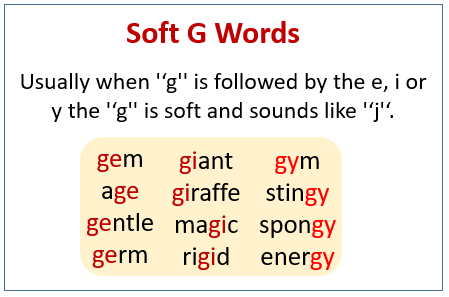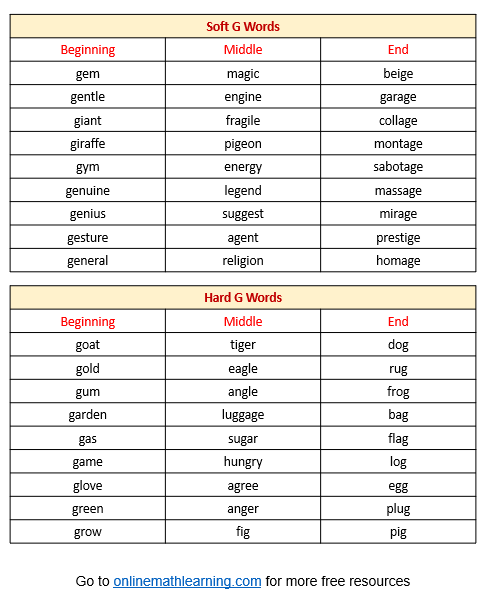Soft G Sound
Related Topics:
Pre-k Lessons & Worksheets
More Math Worksheets
More Printable Math Worksheets
English for Kids
Videos and songs to help Kindergarten kids learn how to pronounce the soft G sound.
Usually, the soft g comes before e,i and y.
Learning the Soft “G” Sound
The soft “G” sound is pronounced /j/, similar to the sound in the letter J.
When Does the Letter “G” Make the Soft Sound?
The soft “G” sound /j/ occurs when the letter G is followed by the vowels E, I, or Y.
Examples of Soft “G” Words:
Before E:
gem, gentle, general, giraffe
Before I:
giant, ginger, magic, engine
Before Y:
gym, gyroscope, allergy, strategy
Free worksheets to help students practice writing the letter G and the Alphabet.
Letter g Worksheet (lower case)
Letter G Worksheet (upper case)
Write Lower Case Letters
Write Upper Case Letters
The following diagram shows some examples of words that have the soft g sound. Scroll down the page for more examples and songs to help you learn how to pronounce words beginning or ending with the g sound.

Have a look at the following diagrams to compare soft G and hard G words for the letter G in the beginning, middle or ending of the words.

Sound of Soft G
Learn the other sound of G.
Soft G
Soft g - Phonics
Soft G song
When you see a ‘G’ in a word before ‘E,’ ‘Y,’ or ‘I’ makes a sound like a ‘J’ and that’s a soft ‘G.’
There sre some exceptions.
Two G Sounds
Grover and George.
Phonics Soft G
G before e, i or y.
Hard and Soft C and G
Learn the sound of the letters
Learning Short Vowels
| Short Vowels | ||
|---|---|---|
| Short A | Short E | Short I |
| Short O | Short U | Short Vowels |
Learning Long Vowels
| Long Vowels | ||
|---|---|---|
| Long A | Long E | Long I |
| Long O | Long U | Y (vowel) |
| Long Vowels | Short & Long Vowels | |
Compare Short & Long Vowels
| Short & Long Vowels | ||
|---|---|---|
| Short & Long A | Short & Long E | Short & Long I |
| Short & Long O | Short & Long U | |
Learning Consonants
Try out our new and fun Fraction Concoction Game.
Add and subtract fractions to make exciting fraction concoctions following a recipe. There are four levels of difficulty: Easy, medium, hard and insane. Practice the basics of fraction addition and subtraction or challenge yourself with the insane level.

We welcome your feedback, comments and questions about this site or page. Please submit your feedback or enquiries via our Feedback page.